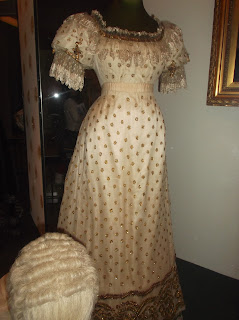The high- waisted styles inspired by classical dress remained popular for the first part of the 19th century. Delicate fans were carried as accessories, while woven cashmere shawls in the Indian style were both decorative and practical. Evening dresses in the 1820's were often made from coloured silk or the newly invented machine made net. Dresses for grand occasions incorporated trimmings of gold tinsel or embroidery, emphasizing the bodice.
Court mantua (1755-60)
The wide hooped skirts of the mantua were already old fashioned in the 1750's, but women were required to wear this cumbersome style to royal assemblies and balls. It required skill to negotiate doorways and carriageways while maintaining a graceful posture.
These are a few more garments that I saw and thought I could use as a source of inspiration and resource.
The pursuit of perfection (1947-1960)
Paris was renowned worldwide as the center for luxurious high fashion. Thousands of people were employed in the trade and it was a vital part of France's economy. After the second world war, designers such as Christain Dior and Givenchy became household names. Their collections dictated changes in style. The exclusive reputation of haute couture depended on it's high quality. Each garment was made to measure for individual clients. This was a hand craft industry. Garments were made by in-house specialist dressmakers and tailors, while embroidery, beading, feather and ribbon work was outsourced from ateliers such as Rebe and Lesage. Increasingly, couture houses opened small boutiques in their foyers offering millinery, underwear, jewellery and perfumes.
As well as these contemporary designers and fashion, there are influences from other places and cultures that have an impact on what these designers create. One of these is Islamic art, and there were some pieces that I saw at the V&A that I just fell in love with. I think one of the reasons for this is because it's a part of who I am - it's my religion and I find it amazing and beautiful anyway.
Mongols invade
The invasions of Iran by pagan Mongols under Ghengis Khan (ruled 1206-27) brought devastation and disruption, especially in the east. But they were followed by a period of increasing prosperity, as the unification of much of Asia under Mongol rule caused a boom in international trade.
Whilst Islam was building and growing as a religion, art was continuing. It included sophisticated court pieces as well as works of religious art, reflecting Islam's role both as a religion and a political system.
As well as the V&A, I went to the Fashion and Textiles museum. It was nice to see where the ideas of different designs and dresses originated from and how they have been changed and developed over time.

The main designers for the period that these dresses were worn in were Hardy Amies and Norman Hartnell, who dressed the Queen for her wedding and her coronation. Amies was successful in business by being able to extract value from his design, while not replicating his brand.








































No comments:
Post a Comment